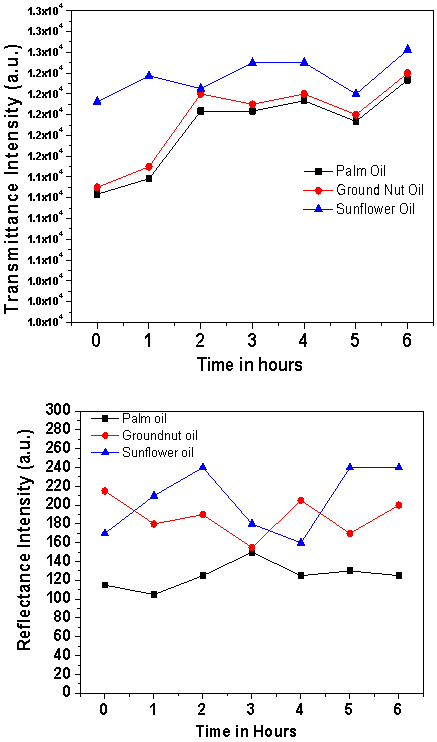-
Paper Information
- Paper Submission
-
Journal Information
- About This Journal
- Editorial Board
- Current Issue
- Archive
- Author Guidelines
- Contact Us
International Journal of Instrumentation Science
p-ISSN: 2324-9994 e-ISSN: 2324-9986
2013; 2(2): 41-45
doi:10.5923/j.instrument.20130202.04
Synthesis and Analysis of Optical Transmission/ Capacitance Bridge System for Oil Deterioration Identification
1Department of Physics, Vidya Vardhini’s A. V. College Vasai Road (W) 401202
2Department of Physics, The Institute of Science, 15, Madam Cama Road, Fort, Mumbai 32 (MS) India
Correspondence to: P. S. More , Department of Physics, The Institute of Science, 15, Madam Cama Road, Fort, Mumbai 32 (MS) India.
| Email: |  |
Copyright © 2012 Scientific & Academic Publishing. All Rights Reserved.
This paper is aimed to design the circuit of optical transmission system oil sensor, for monitoring the deterioration in the edible oil, for example, Sunflower, Palm and Ground nut oil etc. due to moisture react and heating condition. The device packaged to the edible oil, which let every mankind who prepared food at home or hotel to optimize the time for the exchange of edible oil for cooking. By applying the principle of the deterioration of edible oil can be expressed in terms of absorption intensity along with dielectric constant. The capacitance bridge circuit and the optical transmission integrator circuit designed for edible oil to monitor the change due to deterioration because of humidity and varying temperature. In this study, the range of operating temperature of edible oil is experimentally recommended within 80 - 90oC for the stability of a sensor designed. It is concluded that the characteristics of output voltage converted from the dielectric constant are linearly distribute in support of optical absorption/transmission data. Three different samples of edible oil, namely Sunflower, Palm and Ground nut oil at room temperature are studied.
Keywords: Optical Transmission, Oil Deterioration, Capacitance
Cite this paper: A. V. Shelke , P. S. More , Synthesis and Analysis of Optical Transmission/ Capacitance Bridge System for Oil Deterioration Identification, International Journal of Instrumentation Science, Vol. 2 No. 2, 2013, pp. 41-45. doi: 10.5923/j.instrument.20130202.04.
1. Introduction
- Vegetable oils are used in salad, cooking, and as ingredients in several foods. The price of vegetable oil may vary considerable from time to time, depending on production costs and availability. Due to economic importance of oil and fats, it is vital to develop methods to confirm authenticity, to define the composition of blends and to detect adulteration. The biggest problem with deterioration of edible oil is rancidity and the main cause of rancidity is oxidation. The most common analytical assessments of oxidation are provided in terms of Peroxide value, Anisidine value etc. It is now generally agreed that the deterioration (decomposition) of oil and fats, due to the action of air, light and moisture, or the action of micro-organisms, is an oxidative process subsequent to partial hydrolysis. In these two forms of rancidity of pure fats (where the absence of nidus prevents bacterial or mould growth) and that caused by micro-organisms; the course of the oxidation is not the same. Much has been written on the deterioration of pure oil when exposed to atmospheric conditions acquires the characteristic odor. But not any specific instant technique to identify deteriorated oil is reported in the literature[1-4]. When subjected to decomposition, it gives rise to a pungent "perfume" or ester-like odor which is quite different from the pure one. In the present work, the absorption coefficient of vegetable oil was determined using Spectrometer. The variation of the absorption coefficient of vegetable oil with the wavelength is studied. Data indicates that the absorption coefficient of the vegetable oil varies with wavelength. It can be observed that the palm oil has the highest absorption coefficient variation among the oils tested, followed by groundnut oil and sunflower oil. The variation of the absorption coefficient in the range of wavelength studied was maximum for the palm oil compared to the sunflower and groundnut oil.
2. Experimentation
 | Figure 1. Experimental set up of Optical absorption/transmission measurement system |
3. Results and Discussion
- Fig. 2(a), (b), (c) and table 1 shows that the variation in absorption coefficient for Sunflower oil is minimum and for Palm oil is maximum over a wide range of wavelength.
 | Figure 2. Variation of Absorption coefficient w.r. t. wavelength for Sunflower (a), Ground nut oil (b) and Palm oil (c) for all three samples (d) |
 | Figure 3. Variation of Intensity (a. u.) w .r. t. wavelength for Sunflower (a), Ground nut oil (b) Palm oil (c) and for all three samples (d) |
|
 | Figure 4. Variation of Intensity (a. u.) w .r. t. heating time of Sunflower, Ground nut oil and Palm oil |
4. Conclusions
- It is concluded that:(1) The variation of absorption coefficient of oil sample over wide range of wavelength which is observed to be minimum for sunflower oil, and maximum for palm oil. (2) The intensity of transmitted light variation is also minimum for sunflower and maximum for palm oil. (3) Over a range of a heating period in variation in transmittance intensity is minimum for sunflower oil and maximum for palm oil.The oxidation of Sunflower oil varies more (0.06x104 a.u), as compared to both Ground nut oil (0.11 x104 a.u) and Palm oil (0.17 x104 a.u).(4) Over a range of a heating period variation in reflectance intensity is maximum for sunflower oil and minimum for palm oil. The oxidation of Sunflower oil is more (70a.u.), as compared to both Ground nut oil (20 a.u.) and Palm oil (10 a.u.) oils. Thus, the most important application of the present method is to verify the quality of edible oil under oxidative Deterioration and heating conditions, to control the adulteration factor and to have the hygienic stability of the oil.
 Abstract
Abstract Reference
Reference Full-Text PDF
Full-Text PDF Full-text HTML
Full-text HTML